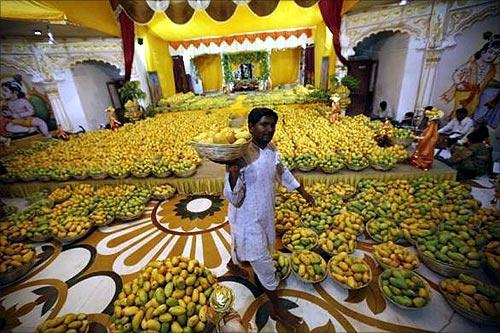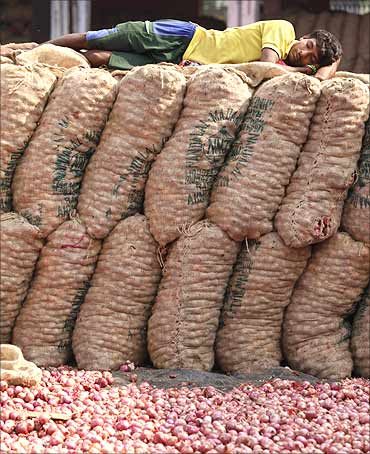Photographs: Reuters. Dilasha Seth in New Delhi
The government has often defended its decision to open multi-brand retail to foreign direct investment (FDI) by saying modernisation of the sector through fresh investment would bring down wastage of fruit and vegetables.
But experts and traders argue the wastage figures cited by the government are not based on any scientific research or study.
For instance, Commerce Minister Anand Sharma has said there is a 35 to 40 per cent wastage in fruit and vegetables in the country. Prime Minister Manmohan Singh, too, in his recent address to the nation, said: "One third of fruit and vegetables at present are wasted due to storage and transit problems."
...
Are the govt's food wastage figures correct?
Photographs: Reuters.
However, the number could just be a "guesstimate" and nobody knows the source of the "35-40 per cent wastage" calculation, say experts.
So, where has the number come from?
"The figure has been in the air for long, so it has become acceptable. However, there is no hard study to back this number," said Pronab Sen, principal adviser in the Planning Commission.
Sen told Business Standard the figure might just be a "guesstimate as he has serious doubts if such a study could even be conducted, especially for vegetables, which are seasonal and too diversified, unlike food grains and fruits".
...
Are the govt's food wastage figures correct?
Photographs: Reuters.
The 35-40 per cent loss claim does not even figure in the Planning Commission's working group report on agriculture marketing infrastructure for the 12th Five-Year Plan.
It states that among vegetables, the post-harvest loss ranges between 6.8 per cent and 12.4 per cent, with the lowest loss in cauliflower and the highest in tomato.
According to a study by the Indian Council on Agricultural Research (ICAR), among fruits, the minimum post-harvest loss is in sapota and the maximum in guava at 18 per cent.
"The number for fruits is still believable as fruits are not seasonal in nature, but vegetables are seasonal, which makes data on production and wastage even difficult," said Sen.
Among cereals, the post-harvest loss ranged from 3.9 per cent to six per cent, with the lowest loss in sorghum and the highest in wheat.
...
Are the govt's food wastage figures correct?
Photographs: Reuters.
In pulses, the lowest loss was seen in chickpea at 4.3 per cent and the highest in black gram at 6.1 per cent.
A department of industrial policy and promotion paper on multi-brand retail in 2010 had said: "As per some industry estimates, 25 to 30 per cent of fruits and vegetables and five to seven per cent of food grains in India are wasted".
This paper quoted industry estimates and not any hard study. However, even this number does not match the 35-40 per cent wastage being cited by the government now.
The traders' community, too, has slammed the government for "cooking up" the figure. "Based on the ICAR study and the Planning Commission working group report, these post-harvest losses are nowhere around the staggering percentage quoted by the government.
It appears that the government is coming up with these bogus figures for making up a case for allowing FDI in multi-brand retail," said Praveen Khandelwal, secretary general of the Confederation of All India Traders.






article